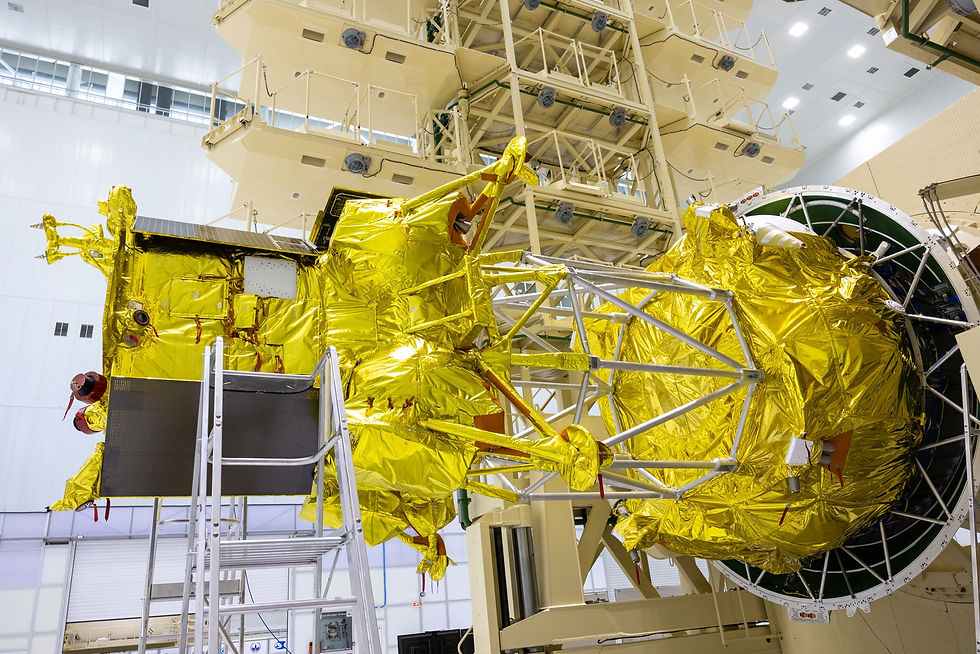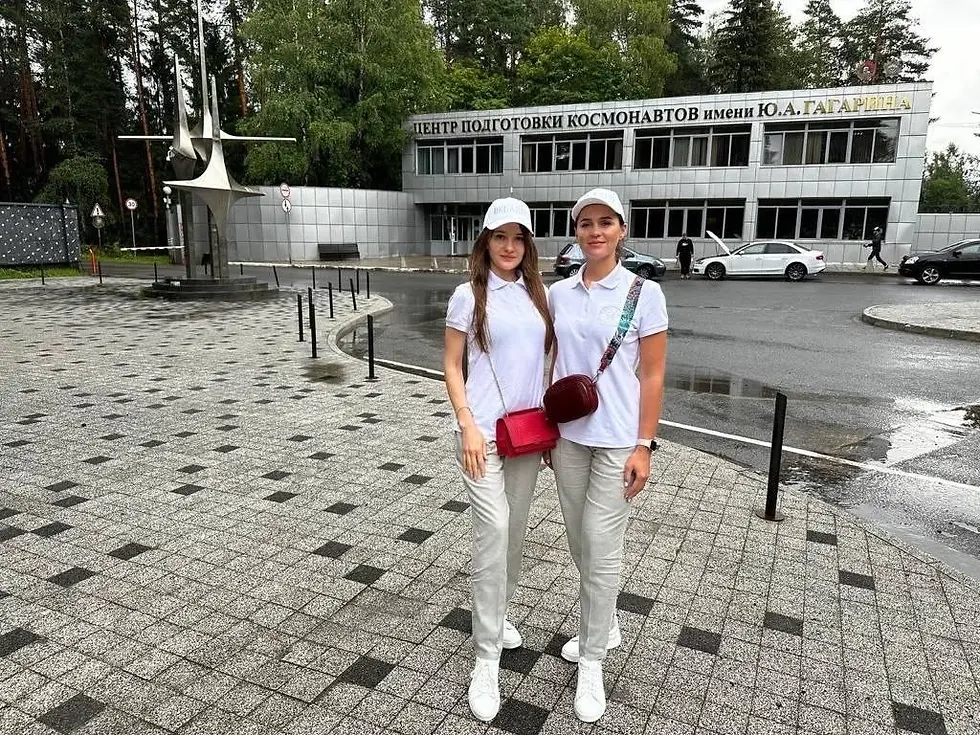Russia launches the Meteor-M No:2-3
- Karthik Naren
- Jun 27, 2023
- 7 min read
A weather satellite and forty-two small spacecraft took off from the Russian Far East spaceport

On June 27, 2023, at 14:34:49.415 Moscow time, the Soyuz-2.1b rocket, with the serial number X15000-010 and equipped with the Fregat upper stage, successfully launched the Meteor-M hydrometeorological spacecraft No. 2-3, along with forty other satellites and two small companion satellites, both of which were of Russian and foreign origin. The rocket took off from platform 1S at the Vostochny Cosmodrome. Apart from the Russian spacecraft, the rocket also carried satellites for various customers using Aerospace Capital deployers.
In terms of payload design and coordination, Glavkosmos, the Russian commercial agency, played a crucial role as the primary work scheduler for the launch service. Through their contractual relationship with the Innovation Promotion Fund, sixteen university educational cubesats from the Space-π (pi) project will be launched under the Planet Duty Officer program. Additionally, nine small satellites were included through the Universat program, which focuses on launching small spacecraft for educational and scientific purposes. Furthermore, another 17 tiny spacecraft are scheduled for launch, serving Russian and foreign commercial customers.

Meteor M
The Meteor-M spacecraft nº 2-3, manufactured by VNIIEM, is designed to solve the problems of hydrometeorological support, climatic and environmental monitoring, the study of the Earth's natural resources, control of the heliogeophysical situation in the near-Earth space, obtaining information from automatic measurement platforms for data collection and retransmission of emergency beacon signals from the international COSPAS-SARSAT satellite search and rescue system.

Compared to Meteor-M No. 2-2, the new satellite is equipped with an onboard radar system based on an array of active-phase antennas and heliogeophysical instruments (a shortwave reflected radiation meter and a radiofrequency mass spectrometer). With the launch of this spacecraft, Russia is fully restoring its contribution to the COSPAS-SARSAT system. The agreement on the COSPAS-SARSAT program was signed on July 1, 1988 by the USSR, Canada, the USA and France. On the eve of the 35th anniversary of the signing of the agreement, this is an important milestone in the maintenance and development of this uniquely humanitarian satellite system.
The satellite is equipped with Fourier infrared spectrometer IKFS-2 – 2; KMSS High-Resolution VIS/IR Radiometer; MSU-MR VIS/IR Imaging Radiometer; MTVZA-GY Imaging/Sounding Microwave Radiometer – Enhanced; SSPD Data Collection and Transmission System; MeteoSAR Synthetic Aperture Weather Radar; GGAK-M/RIMS-M Radio Frequency Mass Spectrometer – M; Radiometer IKOR-M Broadband SW; GGAK-E/SKIF-6; GAK-E / Corpuscular Radiation Spectrometer; GGAK-E/GALS-E GGAK-E / Galactic Cosmic Ray Detector.
Meteor-M No. 1 was launched on September 17, 2009, Meteor-M No. 2 on July 8, 2014, and Meteor-M No. 2-2 on July 5, 2019.
The developer of the 3,250 kg spacecraft was VNIIEM Corporatisiya. The spacecraft will be placed in a circular orbit synchronized with the Sun, with an average altitude of 832 km with a period of 101.3 min, and an inclination of 98.85º. Mean square error of orientation along X, and Y axis is not more than 10 arcs/min, and along Z axis: not more than 15 arc min. Your electrical system consumes a daily average of up to 1,000 watts, maximum for 10 minutes of up to 1,350 watts. The operational useful life must be 5 years in the 1st phase, and in the 2nd phase, seven years. Payload weight reaches 320 kg.
MSU-RM:
µm spectral imaging ranges: — red (0.5 ÷ 0.7); — near-infrared (0.7 ÷ 1.1);
mid-infrared (1.6 ÷ 1.8);
mid-infrared (3.5 ÷ 4.1);
far infrared (10.5 ÷ 11.1);
far infrared (11.5 ÷ 12.5) Capture band (when photographing from orbit 835 km) – 2800 Spatial resolution (projection pixel size on Earth with H=835 km) — < 1.0 km
KMSS:
Number of Spectral Channels – 3 µm Spectral Imaging Tracks:
green MSU-50 (0.37 ÷ 0.45), MSU-100 (0.535 ÷ 0.575);
red MSU-50 (0.45 ÷ 0.51), MSU-100 (0.63 ÷ 0.68);
near-infrared MSU-50 (0.58 ÷ 0.69), MSU-100 (0.76 ÷ 0.9) Capture range with two cameras operating simultaneously 900 km Resolution 60-120 meters
BRLC: The carrier frequency of the sounding signal at 9500-9700 MHz Search bandwidth not less than 600 km Spatial resolution:
0.7×1.0 km low-resolution mode;
0.4×0.5 km medium resolution mode
MTVZA-GYA: The number of channels is 29 Spectral range 10.6 ÷ 183.31 GHz Scan 1500km Spatial resolution 16-198 km
SSPD: The number of platforms served (PSD) is up to 5,000. The number of PSDs served simultaneously is up to 150. Potential information consumers: Hydrometeorological and heliogeophysical services of the Russian Federation and foreign countries

Rideshare Satellites
Avion Kaluga 650, Geoscan 1U alpha, Geoscan 1U beta, Geoscan 1U gamma, Geoscan 3U alpha, Druzhba ATURK, KuzGTU-1, Monitor-2, Nanozond-1, Norbi- 2, StratoSat-TK1 and more 6/8 picosatellites (5x5x5 ) Small Space Systems (ISS) TinySat / Stratonavtika, UmKA-1, Yarilo No. 3, Yarilo No. 4, ArcCube-01, ASRTU-1, CubeSat 3U CSU, SamSat-ION, Svyatobor-1, TyumSat2 (Space-π), Bureau 1440 demonstration satellite, MKA MIPT for testing laser communications, Zorkiy-2M (12U Cubesat from Sputnix), 12 AIS satellites also from Sputniks, and the microsatellites (Glavkosmos “mission 1”) Khors 1 and 2.
A-SEANSAT-PG 1
ArcCube 01
Avion
BSUSat 2
CSTP 1.1
CSTP 1.2
CubeSX-HSE 3 (RS 42S)
impulse 1
Khors 1
Khors 2
Monitor-2 (RS 39S)
MONITOR-3 (RS58S)
MONITOR-4 (RS57S)
NORBI 2
PHI-DEMO
Politekh-Univers 3 (RS 46S)
Rassvet-1 1
Rassvet-1 2
Rassvet-1 3
ReshUCube 2 (RS 37S)
SamSat-ION
Saturn
Sirius-SINP-3U
SITRO-AIS 5
SITRO-AIS 6
SITRO-AIS 7
SITRO-AIS 8
SITRO-AIS 9
SITRO-AIS 10
SITRO-AIS 11
SITRO-AIS 12
StratoSatTK 1
StratoSat TK-1-A
StratoSat TK-1-B
StratoSat TK-1-V
StratoSat TK-1-G
StratoSat TK-1-D
StratoSat TK-1-E
Svyatobor 1
UmKA 1
UTMN 2 (RS 27S)
Vizard-meteo
Yarilo 3
Yarilo 4
Zorkiy 2M
space-pi
Petersburg Polytechnic University (SPbPU), as part of the Space Pi project, will for the first time send a CubeSat with an engine. Earlier, in August 2022, two CubeSats, manufactured at the Polytechnic University on Space Pi, had already entered orbit from the Baikonur Cosmodrome. “… It will be different from previous devices because it will have an engine. We really look forward to seeing how it changes locations. In general, controlling an aircraft in Earth orbit is the number one task, not only here, but all over the world”, said the project manager at a press conference with TASS. According to him, this may open up some perspectives by combining these devices in blocks, that is, it will make it possible to build structures directly in orbit. CubeSats are used to study the level of electromagnetic radiation on the Earth's surface in various frequency bands. In one day, Space Pi devices must perform 30 orbits around the Earth and record electromagnetic radiation on its surface in the range of 0.3 to 18 GHz.
The 3U size satellites called CSTP-1.1, and CSTP-1.2 from the same University are designed to solve the problems of testing new technologies for the development of systems on board spacecraft, as well as analyzing the electromagnetic spectrum of radio sources emitting on the surface of the Earth. Earth. CubeSats are equipped with a three-axis guidance and stabilization system, a high-speed channel for downloading scientific data, and a propulsion system.
PHI-Demo
The United Arab Emirates Mohammed Ben Rashid Space Center (MBRSC) – MBRSC announced that it will launch its first PHI-Demo mission as a joint initiative with the United Nations Office for Outer Space Affairs (UNOOSA). According to the Emirates news agency WAM, the satellite includes an IoT (Internet of Things) communication device developed by local startup OQ Technology as part of the Rashid Space Center's Space Ventures initiative. It will allow storing and forwarding of data collected from internet-connected devices located in remote areas, as well as those used in various industries and autonomous vehicles, using the fifth generation of 5G mobile communications.
The satellite from the United Arab Emirates and the A-SEANSAT PG from Malaysia are in dispensers (ejectors) by Aerospace Capital.
Bureau-1440
The Russian company Bureau-1440 will be launching the Rassvet, Rassvet-1, and Rassvet-2 satellites. Experts believe that Rassvet is the future for organizing direct cell phone communication via satellite – and the devices are similar in parameters to the Starlink or Kuiper satellite constellations.
StratoSat
The RS45S StratoSat TK-1-A satellites are equipped with an on-board computer in AVR architecture, with a working frequency of 16 MHz, current from 12mA to 40mA; operating current of 110mA. Its function is to measure acceleration, angular velocity, temperature, pressure, magnetic field, charge, and discharge currents, and temperatures of external solar panels. Its energy system has an average power of 180 mW, and a load capacity of 2400 mAh, operating at 3.3 V and 5 V – 2 with a maximum current of 3.3 lines at up to 5A, and 5V lines at up to 9A. The onboard radio has a transmission frequency of 436.26 MHz, transmitter power of up to 1 W, and LoRa modulation at 2-FSK, with a transfer rate of 1.2 Kbps. An additional payload is a 5-megapixel camera, ESP32 PN controller, and 16 GB PN memory.
Modernized Fregat tug

On Today's mission, Roscosmos used a modernized version of the Fregat upper stage "serial no 142.02" to deliver 43 payloads in orbit,
The RB "Fregat" upper stage is indeed unique and offers several distinctive features:
1. Multiple Orbit Capability: RB "Fregat" stands out as the only upper stage in the world that can deliver payloads to multiple orbits with different inclinations within a single launch. This flexibility allows for more efficient use of launch vehicles and enables the deployment of satellites into various orbital configurations.
2. Autonomous Control System: RB "Fregat" is equipped with an autonomous control system that addresses navigation challenges from the moment of launch. This system ensures high precision in launching spacecraft by effectively solving navigation problems throughout the mission.
3. Energy Reserves: RB "Fregat" is designed to fulfill the mission objectives of a launch by utilizing its own available energy reserves. This capability enhances its reliability and provides flexibility in adapting to different mission requirements.
The development of the RB "Fregat" upper stage began in the 1990s by JSC NPO Lavochkin, drawing upon the propulsion system of the "Phobos" automatic interplanetary station. Variants of the Fregat upper stage include the Fregat-M, Fregat-SB, and Fregat-MT modifications.
Over 100 Fregat upper stages have been successfully launched to date, demonstrating its consistent and reliable performance in fulfilling mission objectives.
Soyuz-2.1b

The Soyuz-2.1b rocket, 47 meters long and 10.3 meters wide on the fins, has a payload capacity of up to 8,200 kg in low orbit. Its launch weight is 313 tons and in its basic form, it is a three-stage vehicle. It has updated engines with advanced injection systems compared to previous versions installed in the first stage and two main stages. Digital flight control and telemetry systems make it possible to launch from a stationary platform, whereas the platforms of the first Soyuz rockets had to be rotated because the rocket could not roll to change its course towards the desired azimuth during flight.
This was yet another launch of a Soyuz-2 family rocket entirely with a new and highly ecological fuel – naphthyl. Naphthyl is a kind of environmentally friendly hydrocarbon with the use of polymeric additives. Its advantages are the reduction of harmful emissions and a noticeable increase in the mass of the cargo launched into orbit. One of the main reasons for switching from traditional T-1 kerosene to naphthyl was the depletion of the Anastasievsko-Troitskoye field in the Krasnodar Territory. In October 2022, for the first time, a Soyuz-2.1b flew completely fueled with naphthyl. Before that, only the third stage of the Soyuz-2.1b and the second stage of the Soyuz-2.1v were supplied with this fuel.










Comments